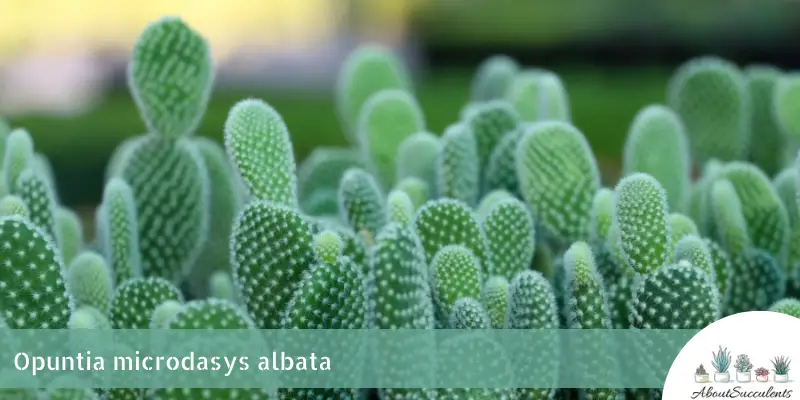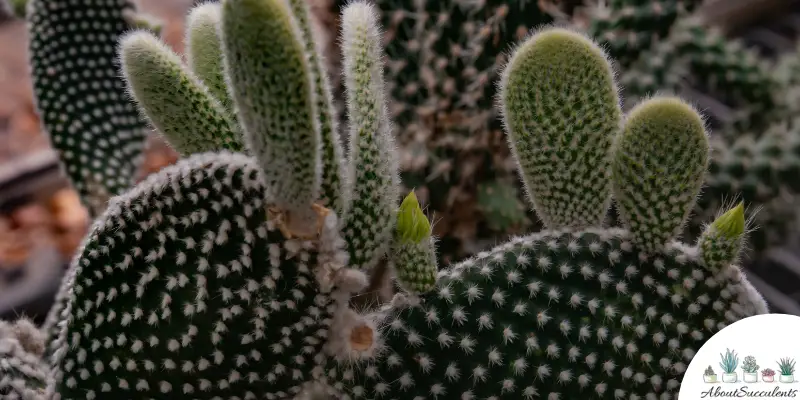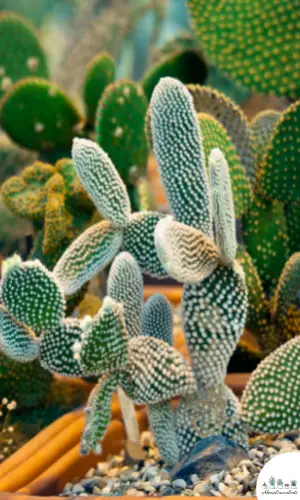
Opuntia Microdasys Albata is an adorable-looking succulent that has endeared itself to many horticulturists because of its almost comical appearance.
This succulent is a member of the Cactaceae family and its oval-shaped pads that grow in pairs are responsible for its alias, “Bunny Ear Cactus” while the glochids that cover it have given the plant other nicknames “Angel Wing Cactus” and “Polka Dot Cactus”.
The glochids are small clusters of prickles that are closely spaced and can form new segments of the plant. Not particularly durable, the glochids can be detached and go drifting in the wind if the pads get hit by a strong breeze.
A fully-grown Angel Wing Cactus can reach a height of 61cm (24”). In the early summertime, this tantalizing succulent can reward you for properly taking care of it with creamy yellow flowers that appear on the mature segments.
Opuntia Microdasys Albata is native to Northern Mexico but has also been known to grow in the desert sections of Arizona, USA.
General Information:
Also known as: Bunny Ear Cactus, Angel Wing Cactus, Polka Dot Cactus.
Plant Family: Cactaceae
Origin: Northern Mexico
Height: 61cm (24”)
Exposure: Full to partial sun for up to 6 hours.
Water Needs: Water the soil only when it’s 100% dry.
Soil Type: Gritty; Cactus mix or one part potting soil with coarse sand or perlite added for better drainage.
Soil pH: 5.0 to 7.5.
How to Grow and Care for Opuntia Microdasys Albata

Whether as part of your outdoor garden or as an indoor houseplant, Opuntia Microdasys Albata is a type of succulent that’s easy to grow and care for.
Sunlight
As a member of the Cactaceae family, Bunny Ear Cactus prefers locations with direct sunlight. Don’t worry if most of your areas in the garden or indoors provide only partial rays of the sun. It’s all the same for this cactus.
There are 2 important things to keep in mind when giving Angel Wing Cactus sunlight. First, is that it should be exposed for up to 6 hours. Second, morning sunlight or late afternoon sun is best for Opuntia Microdasys Albata as the rays are less harsh.
Inside your home, place the succulent plant near a window that receives 6 hours of partial sunlight. If this isn’t possible, put it under a Grow Light.
Watering

Polka Dot Cactus thrives better with fewer waterings. If you give the succulent more water than it needs, the roots will be at risk of rotting.
Always check the moisture level of the soil. You can use a Hygrometer that measures the level of moisture in the soil or you can simply use a stick.
Insert a stick 1-2” deep into the soil. Pull out the stick and give its end a feel. If the end of the stick feels dry, then you can give the soil water.
When watering Opuntia Microdasys Albata, water the soil, not the plant. Give the soil a thorough soaking or up to the point where water is coming out of the drain holes.
Remove the drain tray and empty it of water before placing it back under the pot. If you don’t remove the excess water, the roots will remain in a moist environment.
Pot and Soil
Choose an unglazed pot for Opuntia Microdasys Albata such as one made of ceramic or terracotta. An unglazed pot will allow moisture to leave the soil faster and dry it out completely.
You must also choose a pot that has drain holes with a mesh net cover at the bottom.
The ideal type of soil for Bunny Ear Cactus is a gritty one such as cactus mix. You can also make your own soil by mixing one part of potting soil with perlite or coarse sand to improve drainage.
How to Propagate Opuntia Microdasys Albata
It’s easy to propagate this type of succulent because Opuntia Microdasys Albata will give you pups or offsets.
Step 1: Gently pull out the offsets from the base of the main plant or cut them off with a sterilized knife.
Step 2: Place the offsets in a dry area for 2 to 3 days so they can develop hard calluses.
Step 3: Plant the callused offsets on well-draining cactus soil. Keep the soil lightly moistened until you see the appearance of roots.
Step 4: Once the roots have taken hold in the soil, follow normal watering guidelines and only water when the soil is completely dry.
Frequently Asked Questions
Is Opuntia Microdasys Albata Toxic to Cats and Dogs?
Opuntia Microdasys Albata isn’t included on the list of plants that are toxic to cats and dogs found on the website of the American Society for the Prevention of Cruelty to Animals (ASPCA) as toxic to cats and dogs.
However, the glochids of the plant can be harmful to your pets. Keep your cats and dogs away from Bunny Ear Cactus.
Why Is My Opuntia Microdasys Albata Dying?
Typical of most succulent plants, if your Opuntia Microdasys Albata is growing weaker or dying, the probable causes would be overwatering and pest infestation.
Overwatering
Giving Bunny Ear Cactus water when the soil isn’t completely dry will do more harm than good. In fact, it can lead to your plant’s death.
Keeping the roots in a moistened condition for an extended period of time will cause root rot that can immediately become a full-blown fungal infection. You’ll suspect this to be the case if you notice discoloration on the pads and other parts of the plant.
You can still save Polka Dot Cactus by cutting off the infected parts with a sterilized knife or garden shears.
Then, uproot the plant from its pot and cut off the rotten roots. Prepare a new pot with fresh cactus mix and replant Angel Wing Cactus.
Pest Infestation
Mealybugs will produce white, cotton-like substances on the pads. Scale insects will leave brown patches on the plant. If you don’t remove these substances, your succulent plant can develop a fungal infection.
Wipe these materials off with a cotton ball soaked in 70% isopropyl alcohol. Keep insects away by spraying Polka Dot Cactus with neem oil.
Does Opuntia Microdasys Albata Produce Flowers?
Yes, Opuntia Microdasys Albata produces creamy-yellow flowers in the early summer.
Last Updated on June 9, 2022 by Sofia Lara